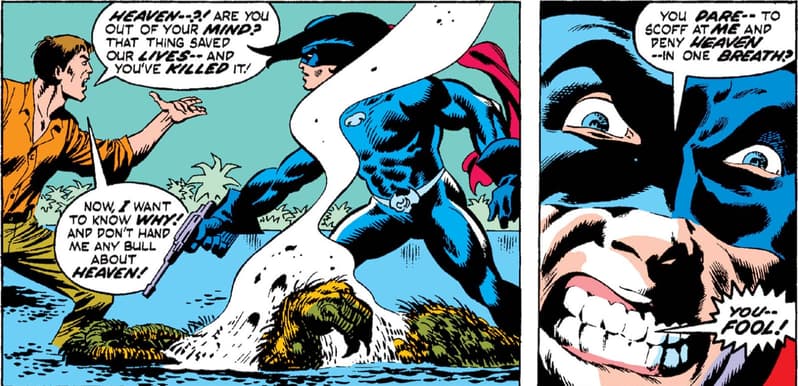Foolkillers: The Best Way to Combat April Fool’s Day
They may have different motives, but they're all targeting the same thing: fools.
To be perfectly clear, Marvel.com is not here to prank you. As fun as it would be to pull a tongue-in-cheek fast one on fans, we’d rather stick to the facts and leave the mischief for the Super Villains. But since everyone still loves a good theme post, we’re spending this April 1 talking about the very villains for the April Fool’s Day occasion – the Foolkillers!
Ross G. Everbest

As trends have proven, an originator will be quickly forgotten and eclipsed by those who come after. Nonetheless, attention must be paid to Ross G. Everbest.
Everbest, even before putting on the costume and acquiring the purification gun, was a zealot. First a follower and then a partner of tent revivalist Reverend Mike Pike, Everbest felt sure he had found his calling. However, one night he stumbled upon Pike enjoying the “Earthly pleasures” with an assortment of other people. Incensed and feeling personally betrayed, Everbest murdered his mentor.
His morality shattered by the experience, Everbest became Foolkiller and set out to punish criminals, anti-war advocates, and the “immoral” alike. Occasionally he did them the solid of giving them 24 hours to change their ways using a calling card that each subsequent Foolkiller would use. More often than not, he just blasted away at those he disagreed with.
In the end, his bizarre decision to put Reverend Pike on display in a tank of formaldehyde proved his undoing. During a struggle with Man-Thing, the display case shattered and a piece of the glass ran Everbest directly through the heart.
Now the first Foolkiller literally dwells in Hell, subjected to Mephisto’s machinations and a series of gladiatorial battles against similarly incorrectly righteously indignant souls.
Gregory Salinger

The second and current Foolkiller received inspiration from his predecessor in the most limited of ways. He heard the story of Everbest from a cellmate and found it stirring enough to then steal the deceased man’s gear. However, Salinger had no particular interest in the previous mantle holder’s religiosity. Instead Salinger defined his mission by the poetic. The bland, the uninteresting, the greedy, and the cruel lacked a poetic nature and therefore needed to be eliminated. He did not seem all that worried about sin, provided that the sin had been done with vigor and joy, evidently.
When a homeless man’s errant comment that no one except a fool would tangle with Spider-Man derailed Salinger’s whole view of himself, he attempted suicide. Stopped from doing so, he turned himself over to a mental health facility.
For a time, he tried to manipulate the third Foolkiller, Kurt Gerhardt. However, when Gerhardt aimed even higher in his goals than Salinger ever did, he began to ignore his predecessor.
Although this initially caused Salinger to backslide, it inspired him to finish his master’s degree in psychology and become a therapist. He still operated as Foolkiller but as more of a mercenary with vaguely good intentions. Last seen, Salinger continued to balance this double life as part of an agreement with S.H.I.E.L.D. He tried to help Super Villains via therapy until he deems them incurable, at which point he has been given permission to kill them.
Kurt Gerhardt

Merging Salinger’s expanded view of fools with Everbest’s zealotry, Gerhardt proved the most attention-grabbing and violent of the Foolkillers. At the end of his rope following his father’s murder, his job loss, and the dissolution of his marriage, Gerhardt heard Salinger on a talk show one night.
Initially planning to argue with Salinger about his viewpoint, Gerhardt called the show. While on hold, however, Gerhardt ended up slowly won over by what he thought Salinger had been arguing. By the time the show let him speak to the second Foolkiller, all Gerhardt wanted was to be able to write Salinger.
This began their symbiotic relationship. Salinger gave Gerhardt tips and clues on how to be the best Foolkiller he could be while Gerhardt did the deeds. Before long, however, Gerhardt decided he had outgrown Salinger and adopted a new costume and an even nastier approach. While not a reactionary like Everbest, he shared Everbest’s distaste for counterculture and protestors. And while not interested in the poetic like Salinger, he shared his predecessor’s dislike for the selfish and greedy.
In the end, Gerhardt had to fake his death and scar his face with acid to escape punishment at the hands of the police. He did show up in the Vault at some point after that, but no information has ever been provided about how he ended up there or if he ever killed fools again.
Mike Trace
MAX’s Foolkiller, Trace had an almost serial killer’s sensibility to his efforts. He liked to create “works of art” with his violence with heavy emphasis on ironic killings. Though he did share some sense of mission with the previous Foolkillers—his definition of “fool” skewed closest to Salinger but was by no means the same—he seemed far more in line with a violent street vigilante (similar to the Punisher). He employed a calling card as well, but broke slightly with tradition. He favored the tarot card of the Fool and never gave warnings to any future victims to change their ways.
See? No prank! All treat, no trick! Be sure to keep your wits about you today and let anyone who tries to prank you know you don’t appreciate it. However, never be like these Foolkillers. They are not good role models.





